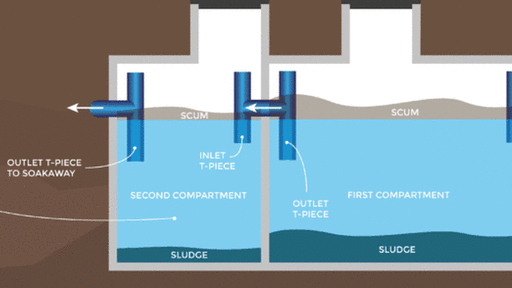What size should my Septic Tank, Treatment Plant or Cesspit be?

Size does matter
The UKDP guide to getting the right size of septic tank, treatment plant or cesspit.
Just like people, septic tanks, treatment plants and cesspits come in all sorts of shapes and sizes. Size really does matter when it comes to such matters (no matter what anyone else says).
If your property's drainage system is too small, it won't be able to cope with the amount of wastewater your property (or its inhabitants) produces, and this can cause all sorts of unpleasant problems. You'll also have issues if the drainage system is too big, because without the right flow of wastewater through it, it won't be able to function as it should.
So, how do you know what size your septic tank, treatment plant or cesspit should be?
Here's the UKDP guide to help you work it out. As someone who is far from a maths whizz, I have tried to keep it as simple as possible, but if you have any questions at all just drop our team a line. You should also know that there are various different interpretations out there as to how these things should be calculated, but we've outlined here what we believe are the most logical and straightforward versions to use.
This guide also only relates to domestic properties, since it gets a whole lot more complicated for commercial properties - we can still help you with this though, so just give our team a call.
What size should a treatment plant be?
Generally speaking, the size of domestic treatment plants is calculated based on the number of bedrooms the property has. Here's how it works:
- A treatment plant for a single house with up to and including 3 bedrooms shall be designed for a minimum population (P) of 5 people
- The size of a treatment system for a single house with more than 3 bedrooms shall be designed by 1 P for each additional bedroom to the minimum single house value of 5 P e.g.
- house with 3 bedrooms = minimum 5P system
- house with 4 bedrooms = minimum 6P system (5+1)
- house with 6 bedrooms = minimum 8P system (5+3)
Are you still with me? Good.
Here comes the slightly more complicated bit when it comes to treatment plants shared by a group of houses, so get the kettle on and we'll give it a whirl.
For a group of 2 houses (3 and 4 bedrooms respectively), the system should be a minimum of 11P (5+6 as per the guidelines above).
If the calculated total P for a group of houses exceeds 12P, then some reduction may be made to allow for the balancing effects on daily flow of a group of houses, like this:
- Where the total is 13-25P, multiply the total by 0.9 to give an adjusted P value e.g. if there are four 4 bedroom houses, the total P would be 24P (4 x 6) and the adjusted P would be 22P (24 x 0.9 = 21.6). Note that the P value should always be rounded up not down.
- Where the total is 26-50P, multiply the total by 0.8 to give an adjusted P value e.g. if there are four 3 bedroom houses and three 4 bedroom houses, the total P will be 38 P (4 x 5 and 3 x 6) and the adjusted P will be 31P (38 x 0.8 = 30.4)
You'll find more information on this on the British Water website, in a document called Flows and Loads.
What size should a septic tank be?
Luckily this one is a little more straightforward. The size of a septic tank is based on its capacity, and it should have a capacity below the level of the inlet of at least 2,700 litres for up to 4 users. This size should be increased by 180 litres for each additional users. Here's a diagram which shows where the inlet typically sits within a septic tank:

It's easy to get confused between the change in unit from 'P' in the treatment plant calculations above, to 'users' for septic tanks and cesspits. They are pretty much the same thing. The reason they are different is because sizing for septic tanks and cesspits is dictated by Building Control regulations, which you can find here.
So, if you have a house with 4 bedrooms that requires a septic tank, using the calculation above for a treatment plant this would require a 6P system. Translate this into a 6 user septic tank. If 2,700 litres is the capacity of the tank for 4 users, then you would add 2 more users at 180 litres each, which would give you a total of a tank with a capacity of 3,060 required.
What size should a cesspit be?
A cesspit (or cesspool, it's the same thing) should have a capacity below the level of the inlet of at least 18,000 litres for 2 users. This size should be increased by 6,800 litres for each additional user. Using the same theory with septic tank calculations, if we were trying to size up a cesspit for a house with 4 bedrooms, we would work to 6 users. If 18,000 litres is the minimum for 2 users, then you would need to add 4 x 6,800 which would give a total size tank required of 45,200 litres.
It's really important to get the size of your drainage system right to avoid septic tank problems, treatment plant problems or cesspit problems in the future. Of course, the size of the tank you use is just one element that needs to be right when installing a septic tank, treatment plant or cesspit.
If you're having any problems with your current system, call us to chat it through, we may be able to help get the costs of any repair or replacement needed through your buildings insurance.
Let's stay in touch! Sign up for our helpful newsletter today

Sam's career prior to UKDP was spent in the marketing and service industries, so she is focused on making sure we look after our customers – and getting the UKDP message out there! Sam has overall responsibility for business operations and for delivering the best customer service we can.


